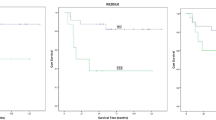Purpose:
To evaluate the outcome and prognostic factors of adult patients with medulloblastoma.
Patients and Methods:
26 adult medulloblastoma patients with a median age of 27 were subjected to craniospinal radiotherapy. A dose of 30.6 Gy with 1.8 Gy/fraction/day was prescribed to M0 patients, while 36 Gy were to be applied in patients with positive cerebrospinal liquor findings. The posterior fossa was boosted to 54 Gy. While 20 patients underwent external-beam radiotheray alone, only six received sequential adjuvant chemotherapy.
Results:
Male/female ratio was 1.2. Preradiotherapy Karnofsky performance status was recorded as median 100%. 50% were classified as poor risk (n = 10, subtotal resection; n = 3, M+). The median follow-up time was 46.5 months. The 5-year actuarial survival rates for recurrence-free, distant metastasis-free, disease-free, and overall survival were 82.5%, 90.8%, 73.5%, and 89.7%, respectively. Patient characteristics, treatment factors and tumor characteristics failed to show any significance in univariate analysis. Grade 3 or 4 late morbidities were not observed.
Conclusion:
Yet, the current standard of care seems to remain craniospinal irradiation after maximal surgical resection of the primary neoplasm without clear indications for adjuvant chemotherapy.
Ziel:
Evaluation der Ergebnisse und Prognosefaktoren bei erwachsenen Patienten mit Medulloblastom.
Patienten und Methodik:
Insgesamt 26 erwachsene Patienten mit Medulloblastom (medianes Alter 27 Jahre) wurden kraniospinal bestrahlt. Dabei erhielten M0-Patienten eine Gesamtdosis von 30,6 Gy in Einzelfraktionen von 1,8 Gy/Tag, und bei Patienten mit einem positiven Liquorbefund wurden insgesamt 36 Gy appliziert. Die hintere Schädelgrube wurde bis zu einer Gesamtdosis von 54 Gy geboostet. 20 Patienten erhielten eine alleinige postoperative Bestrahlung, sechs Patienten eine sequentielle adjuvante Chemotherapie.
Ergebnisse:
Das Verhältnis von Männern zu Frauen lag bei 1,2. Der vor der Strahlentherapie bestehende mediane Karnofsky-Index betrug 100%. 50% der Patienten wurden als Hochrisikopatienten eingestuft (subtotale Resektion: n = 10, M+: n = 3). Die mediane Nachbeobachtungszeit betrug 46,5 Monate. Die Überlebensraten nach 5 Jahren für das rezidivfreie Überleben, das metastasenfreie Überleben, das krankheitsfreie Überleben und das Gesamtüberleben lagen bei 82,5%, 90,8%, 73,5% und 89,7%. Es fanden sich keine signifikanten Prognosefaktoren in der univariaten Analyse. Spättoxizitäten des Grades 3 oder 4 wurden ebenfalls nicht beobachtet.
Schlussfolgerung:
Die Standardbehandlung von Patienten mit einem Medulloblastom im Erwachsenenalter bleibt die kraniospinale Bestrahlung nach maximaler chirurgischer Resektion, ohne klare Indikation für eine adjuvante Chemotherapie.
Similar content being viewed by others
Author information
Authors and Affiliations
Corresponding author
Rights and permissions
About this article
Cite this article
Selek, U., Zorlu, F., Hurmuz, P. et al. Craniospinal Radiotherapy in Adult Medulloblastoma. Strahlenther Onkol 183, 236–240 (2007). https://doi.org/10.1007/s00066-007-1563-y
Received:
Revised:
Issue Date:
DOI: https://doi.org/10.1007/s00066-007-1563-y




